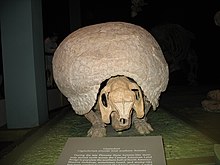Glyptotherium
| Glyptotherium Temporal range: Pleistocene
| |
|---|---|

| |
| G. arizonae | |
| Scientific classification | |
| Kingdom: | |
| Phylum: | |
| Class: | |
| Superorder: | |
| Order: | |
| Family: | |
| Subfamily: | |
| Genus: | †Glyptotherium
|
| Species | |
| |
Glyptotherium is an extinct genus of glyptodont, a group of extinct mammals related to the armadillos living from Early Pliocene to Late Pleistocene (4.1 to 0.012 million years ago) (AEO). The genus is considered an example of North American megafauna, of which most have become extinct. Glyptotherium may have been wiped out by climate change or human interference.[1]
Like its living relative, the armadillo, Glyptotherium had a shell which covered its entire body, similar to a turtle. However, unlike a turtle's shell, the Glyptotherium shell was made up of hundreds of small six-sided scales. Some species grew up to six feet long and its armor weighed up to a ton.
Remains of Glyptotherium species have been found in tropical and subtropical regions of Venezuela, Central America, Mexico, and the southern United States from Florida and South Carolina to Arizona.[1] There is no direct evidence of humans preying on this North American glyptodont. Smilodon may have occasionally preyed upon Glyptotherium, based on a skull from one Glyptotherium fossil recovered from Pleistocene deposits in Arizona bearing the distinctive elliptical puncture marks that best match those of the machairodont cat, indicating that the predator successfully risked biting into bone to kill the armored herbivore, the only option for a predator intent on hunting such heavily armored animals.[2] The Glyptotherium in question was a juvenile, with a still-developing head shield, making it far more vulnerable to the cat's attack.[3] Glyptotherium was named by Osborn in 1903, assigned to Glyptodontinae by Downing and White in 1995 and to Glyptodontidae by Osborn (1903), Brown (1912), Carroll (1988), Cisneros (2005) and Mead et al. (2007).
Gallery
-
Restoration
-
Juvenile G. texanum skull, possibly attacked by a Smilodon[3]
See also
References
- ^ "Glyptotherium Osborn 1903". Paleobiology Database. Retrieved 2014-09-09.
- ^ Antón, Mauricio (2013). Sabertooth. Bloomington, Indiana: University of Indiana Press. pp. 203–204. ISBN 9780253010421.
- ^ a b Gillette, D. D. (Spring 2010). "Glyptodonts in Arizona". Arizona Geology. Arizona Geological Survey. Retrieved 2018-08-17.
- "AMNH Bestiary". Retrieved 2006-06-18.


![Juvenile G. texanum skull, possibly attacked by a Smilodon[3]](http://upload.wikimedia.org/wikipedia/commons/thumb/3/3c/Glyptotherium_texanum.JPG/120px-Glyptotherium_texanum.JPG)